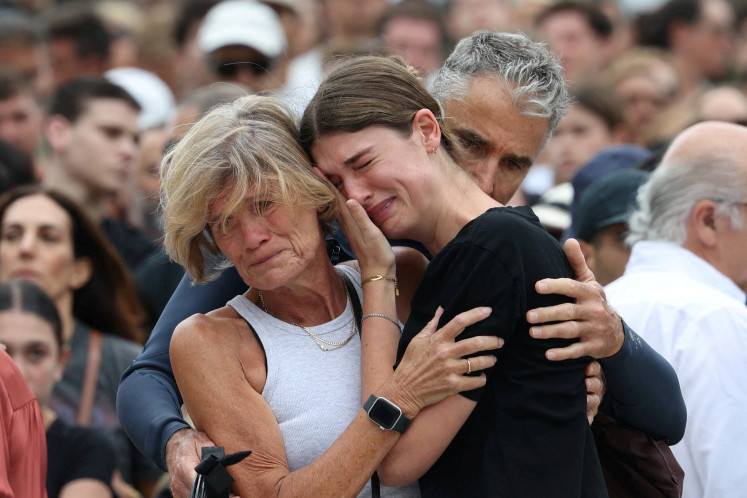Popular Reads
Top Results
Can't find what you're looking for?
View all search resultsPopular Reads
Top Results
Can't find what you're looking for?
View all search resultsJapan quake toll rises to 62 as weather hampers rescuers
The 7.5-magnitude quake on January 1 that rattled Ishikawa prefecture on the main island of Honshu triggered tsunami waves more than a metre high, sparked a major fire and tore apart roads.
Change text size
Gift Premium Articles
to Anyone
 Firefighters inspect collapsed wooden houses in Wajima, Ishikawa prefecture on January 2, 2024, a day after a major 7.5 magnitude earthquake struck the Noto region in Ishikawa prefecture in the afternoon. Japanese rescuers battled against the clock and powerful aftershocks on January 2 to find survivors of a major earthquake that struck on New Year's Day, reportedly killing more than 20 people and leaving a trail of destruction.
(AFP/Kazuhiro Nogi)
Firefighters inspect collapsed wooden houses in Wajima, Ishikawa prefecture on January 2, 2024, a day after a major 7.5 magnitude earthquake struck the Noto region in Ishikawa prefecture in the afternoon. Japanese rescuers battled against the clock and powerful aftershocks on January 2 to find survivors of a major earthquake that struck on New Year's Day, reportedly killing more than 20 people and leaving a trail of destruction.
(AFP/Kazuhiro Nogi)
J
apanese rescuers scrambled to search for survivors Wednesday as authorities warned of landslides and heavy rain after a powerful earthquake that killed at least 62 people.
The 7.5-magnitude quake on January 1 that rattled Ishikawa prefecture on the main island of Honshu triggered tsunami waves more than a metre high, sparked a major fire and tore apart roads.
The Noto Peninsula of the prefecture was most severely hit, with several hundred buildings ravaged by fire and houses flattened in several towns, including Wajima and Suzu, as shown by before-and-after satellite images released on Wednesday.
The regional government announced Wednesday that 62 people had been confirmed dead and more than 300 injured, 20 of them seriously.
The toll was expected to climb as rescuers battle aftershocks and poor weather to comb through rubble.
More than 31,800 people were in shelters, the government said.
"More than 40 hours have passed since the disaster. We have received a lot of information about people in need of rescue and there are people waiting for help," Prime Minister Fumio Kishida said Wednesday after an emergency task force meeting.
"Rescue efforts are being made by the local authorities, police, firefighters and other operational units, while the number of personnel and rescue dogs is enhanced.
"However, we ask you to remain fully mindful that we are in a race against time and to continue to do your utmost to save lives, putting people's lives first," Kishida said.
The operation was given extra urgency as the Japan Meteorological Agency (JMA) issued a heavy rain warning in the area.
"Be on the lookout for landslides until the evening of Wednesday," the agency said.
In the coastal city of Suzu, mayor Masuhiro Izumiya said there were "almost no houses standing".
"About 90 percent of the houses (in the town) are completely or almost completely destroyed... the situation is really catastrophic," he said, according to broadcaster TBS.
A woman at a shelter in the town of Shika told TV Asahi that she "hasn't been able to sleep" due to aftershocks.
"I've been scared because we don't know when the next quake will hit," she said.
Nearly 34,000 households were still without power in Ishikawa prefecture, the local utility said.
Many cities were without running water.
Shinkansen bullet trains and highways have resumed operations after several thousand people were stranded, some for almost 24 hours.
The US Geological Survey said the quake had a magnitude of 7.5, while the JMA measured it at 7.6, triggering a major tsunami warning.
The powerful quake was one of more than 400 to shake the region through Wednesday morning, the JMA said.
Japan lifted all tsunami warnings after waves at least 1.2 metres (four feet) high hit the town of Wajima and a series of smaller tsunamis were reported elsewhere.
Japan experiences hundreds of earthquakes every year and the vast majority cause no damage.
The number of earthquakes in the Noto Peninsula region has been steadily increasing since 2018, a Japanese government report said last year.
The country is haunted by a massive 9.0-magnitude undersea quake off northeastern Japan in 2011, which triggered a tsunami that left around 18,500 people dead or missing.
It also swamped the Fukushima atomic plant, causing one of the world's worst nuclear disasters.








